Atmospheric Pollution Research ( IF 4.5 ) Pub Date : 2021-07-08 , DOI: 10.1016/j.apr.2021.101136 Ahmad Hassan 1 , Muhammad Zeeshan 2 , Muhammad Faraz Bhatti 2

|
Microbiological air pollutants i.e. airborne bacteria and fungi in public libraries are a potential risk to human health and paper heritage. The present study aims to investigate the variation of indoor and outdoor microbial air quality in the libraries of a public university in relation to ventilation system type, microenvironmental conditions and outdoor microbial concentrations. To determine the bacterial and fungal concentrations, air samples were collected on TSA and PDA media respectively. Fungal and bacterial concentrations ranged within 20–250 CFU/m3 and 20–230 CFU/m3 in indoor and 280–510 CFU/m3 and 20–100 CFU/m3 in the outdoor, respectively. Indoor/Outdoor ratio was lower than 1 for fungi and exceeded 1 for bacteria, indicating that outdoor (plants, soil, waste food, etc.) is the main source of fungi whereas, for bacteria, it is indoor (occupants and their activities). Penicillium spp. (43.6%), Cladosporium spp. (30.5%), and Aspergillus spp. (13%) were found as the dominant fungal genera whereas Bacillus spp. (35%), Staphylococcus spp. (23%), and Micrococcus spp. (18%) were prevailing in monitored libraries. Considering much higher (almost 15 times) occupancy in the library with central mechanical heating ventilation and air conditioning (HVAC) system, the airborne bacterial and fungal concentrations were expected to be higher accordingly. However, the concentration were comparable to those in the buildings facilitated with natural ventilation which indicate that better performance of centralized HVAC system helped neutralizing the effect of higher occupancy on air quality..
中文翻译:

自然通风和机械通风的大学图书馆室内外微生物空气质量
公共图书馆中的微生物空气污染物,即空气传播的细菌和真菌,对人类健康和纸张遗产构成潜在风险。本研究旨在调查与通风系统类型、微环境条件和室外微生物浓度相关的公立大学图书馆室内和室外微生物空气质量的变化。为了确定细菌和真菌浓度,分别在 TSA 和 PDA 培养基上收集空气样品。室内真菌和细菌浓度范围为 20–250 CFU/m 3和 20–230 CFU/m 3以及 280–510 CFU/m 3和 20–100 CFU/m 3在室外,分别。室内/室外比对于真菌而言低于 1,对于细菌而言超过 1,表明室外(植物、土壤、垃圾食品等)是真菌的主要来源,而对于细菌而言,则是室内(居住者及其活动) . 青霉属 (43.6%),枝孢菌属。(30.5%) 和曲霉属。(13%) 被发现为优势真菌属,而芽孢杆菌属。(35%),葡萄球菌属。(23%) 和微球菌属 (18%) 在受监控的图书馆中占主导地位。考虑到配备中央机械供暖通风和空调 (HVAC) 系统的图书馆的占用率要高得多(几乎是 15 倍),因此预计空气中细菌和真菌的浓度会相应地更高。然而,浓度与自然通风促进的建筑物中的浓度相当,这表明中央暖通空调系统的更好性能有助于中和较高的入住率对空气质量的影响。.



























 京公网安备 11010802027423号
京公网安备 11010802027423号